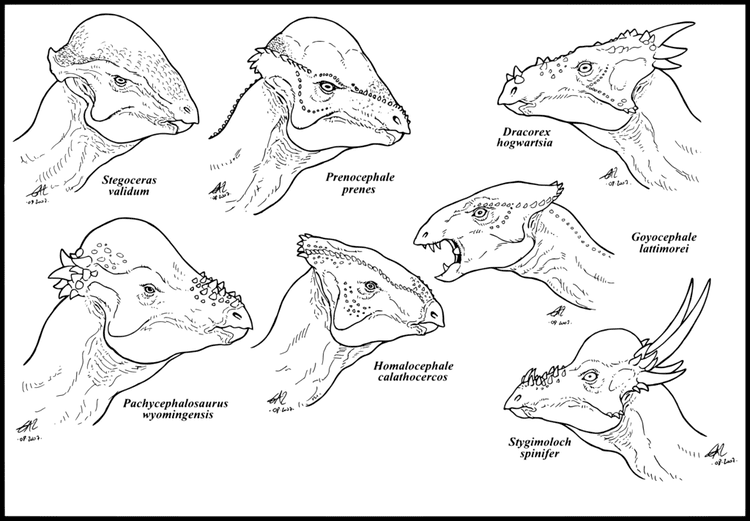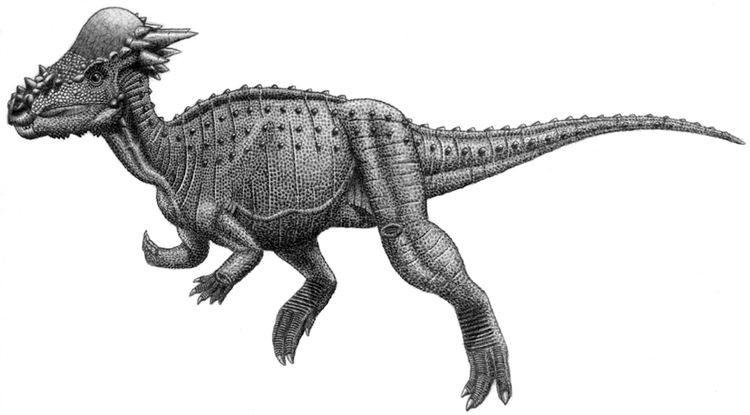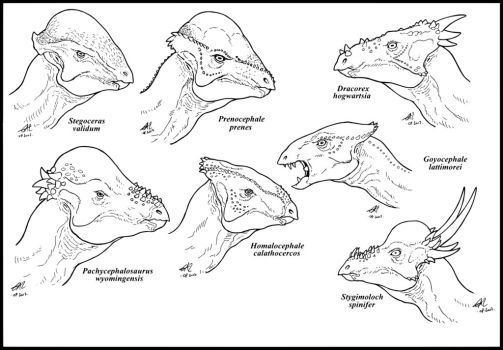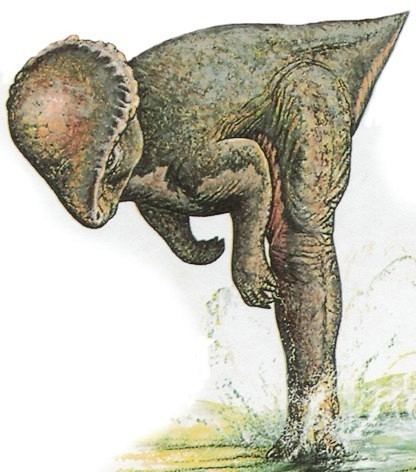Scientific name Pachycephalosauria Order Ornithischia | ||
 | ||
Lower classifications Pachycephalosaurus, Stegoceras, Stygimoloch, Dracorex | ||
Pachycephalosauria (/ˌPæKiˌSɛfələˈsɔːriə, ˌkɛ-/; from Greek παχυκεφαλόσαυρος for 'thick headed lizards') is a clade of ornithischian dinosaurs. Genera include Pachycephalosaurus, Stegoceras, and Prenocephale. Most lived during the Late Cretaceous Period, in what is now North America and Asia. They were all bipedal, herbivorous/omnivorous animals with thick skulls. In some fossils, the skull roof is domed and several centimeters thick; in others it is flat or wedge-shaped. While the flat-headed pachycephalosaurs are traditionally regarded as distinct species or even families, they may represent juveniles of dome-headed adults. The domes were often surrounded by nodes and/or spikes.
Contents
- Ankylosaurus vs pachycephalosauria
- Head butting behaviorEdit
- DietEdit
- PaleopathologyEdit
- ClassificationEdit
- TaxonomyEdit
- PhylogenyEdit
- References

Candidates for the earliest known pachycephalosaur include Ferganocephale adenticulatum from Middle Jurassic Period strata of Kyrgyzstan and Stenopelix valdensis from Early Cretaceous strata of Germany, although R.M. Sullivan has doubted that either of these species are pachycephalosaurs.

Ankylosaurus vs pachycephalosauria
Head-butting behaviorEdit

The adaptive significance of the skull dome has been heavily debated. The popular hypothesis among the general public that the skull was used in head-butting, as sort of a dinosaurian battering ram, was first proposed by Colbert 1955. This view was popularized in the 1956 science fiction story "A Gun for Dinosaur" by L. Sprague de Camp. Many paleontologists have since argued for the head-butting hypothesis, including Galton 1970 and Sues 1978. In this hypothesis, pachycephalosaurs rammed each other head-on, as do modern-day mountain goats and musk oxen.

Anatomical evidence for combative behavior includes vertebral articulations providing spinal rigidity, and the shape of the back indicating strong neck musculature. It has been suggested that pachycephalosaurs could make their head, neck, and body horizontally straight, in order to transmit stress during ramming. However, in no known dinosaur can the head, neck, and body be oriented in such a position. Instead, the cervical and anterior dorsal vertebrae of pachycephalosaurs show that the neck was carried in an "S"- or "U"-shaped curve.
Also, the rounded shape of the skull would lessen the contacted surface area during head-butting, resulting in glancing blows. Other possibilities include flank-butting, defense against predators, or both. The relatively wide build of pachycephalosaurs (which would protect vital internal organs from harm during flank-butting) and the squamosal horns of the Stygimoloch (which would have been used to great effect during flank-butting) add credence to the flank-butting hypothesis.
A histological study conducted by Goodwin & Horner 2004 argued against the battering ram hypothesis. They argued that the dome was "an ephemeral ontogenetic stage", the spongy bone structure could not sustain the blows of combat, and the radial pattern was simply an effect of rapid growth. Later biomechanical analyses by Snively & Cox 2008 and Snively & Theodor 2011 concluded, however, that the domes could withstand combat stresses. Lehman 2010 argued that the growth patterns discussed by Goodwin and Horner are not inconsistent with head-butting behavior.
Goodwin & Horner 2004 instead argued that the dome functioned for species recognition. There is evidence that the dome had some form of external covering, and it is reasonable to consider the dome may have been brightly covered, or subject to change color seasonally. Due to the nature of the fossil record, however, it cannot be observed whether or not color played a role in dome function.
Longrich, Sankey & Tanke 2010 argued that species recognition is an unlikely evolutionary cause for the dome because dome forms are not notably different between species. Because of this general similarity, several genera of Pachycephalosauridae have sometimes been incorrectly lumped together. This is unlike the case in ceratopsians and hadrosaurids, which had much more distinct cranial ornamentation. Longrich et al.. argued that instead the dome had a mechanical function, such as combat, one which was important enough to justify the resource investment.
New findings published in the Journal Plos One on July 16, 2013 further evidence head-butting in species of pachycephalosaurs. Of the 100 domes studied, 20 percent showed signs of healed injuries, all consistent with combative behavior. The pathologies included pitting where the bone had become infected from wounds that originated in the skin. These findings further imply that pachycephalosaurids may have been using their heads for both display and defense as many modern animals do.
DietEdit
With respect to their diet, Mallon et al. (2013) examined herbivore coexistence on the island continent of Laramidia, during the Late Cretaceous. It was concluded that pachycephalosaurids were generally restricted to feeding on vegetation at, or below, the height of 1 meter.
PaleopathologyEdit
Peterson et al. (2013) studied cranial pathologies among the Pachycephalosauridae and found that 22% of all domes examined had lesions that are consistent with osteomyelitis, an infection of the bone resulting from penetrating trauma, or trauma to the tissue overlying the skull leading to an infection of the bone tissue. This high rate of pathology lends more support to the hypothesis that pachycephalosaurid domes were employed in intra-specific combat. The frequency of trauma was comparable across the different genera in this family, despite the fact that these genera vary with respect to the size and architecture of their domes, and fact that they existed during varying geologic periods. These findings were in stark contrast with the results from analysis of the relatively flat-headed pachycephalosaurids, where there was an absence of pathology. This would support the hypothesis that these individuals represent either females or juveniles, where intra-specific combat behavior is not expected.
Histological examination reveals that pachycephalosaurid domes are composed of a unique form of fibrolamellar bone which contains fibroblasts that play a critical role in wound healing, and are capable of rapidly depositing bone during remodeling. Peterson et al. (2013) concluded that, taken together, the frequency of lesion distribution and the bone structure of frontoparietal domes, lends strong support to the hypothesis that pachycephalosaurids used their unique cranial structures for agonistic behavior.
ClassificationEdit
Most pachycephalosaurid remains are not complete, usually consisting of portions of the frontoparietal bone that forms the distinctive dome. This can make taxonomic identification a difficult task, as the classification of genera and species within Pachycephalosauria relies almost entirely on cranial characteristics. Consequently, improper species have historically been appointed to the clade. For instance, Majungatholus, once thought to be a pachycephalosaur, is now recognized as a specimen of the abelisaurid theropod Majungasaurus. And Yaverlandia, another dinosaur initially described as a pachycephalosaurid, has also recently been reclassified as a coelurosaur (Naish in Sullivan 2006). Further complicating matters are the diverse interpretations of ontogenetic and sexual features in pachycephalosaurs.
A 2009 paper proposed that Dracorex and Stygimoloch were just early growth stages of Pachycephalosaurus, rather than distinct genera.
TaxonomyEdit
The Pachycephalosauria was first named as a suborder of the order Ornithischia by Maryańska & Osmólska 1974. They included within it only one family, the Pachycephalosauridae. Later researchers, such as Michael Benton, have ranked it as an infraorder of a suborder Cerapoda, which unites the ceratopsians and ornithopods. In 2006, Robert Sullivan published a re-evaluation of pachycephalosaur taxonomy. Sullivan considered attempts by Maryańska and Osmólska to restrict the definition of Pachycephalosauria redundant with their Pachycephalosauridae, since they were diagnosed by the same anatomical characters. Sullivan also rejected attempts by Sereno 1986, in his phylogenetic studies, to re-define Pachycephalosauridae to include only "dome-skulled" species (including Stegoceras and Pachycephalosaurus), while leaving more "basal" species outside that family in Pachycephalosauria. Therefore, Sullivan's use of Pachycephalosauridae is equivalent to Sereno and Benton's use of Pachycephalosauria.
Sullivan diagnosed the Pachycephalosauridae-based only on characters of the skull, with the defining character being a dome-shaped frontoparietal skull bone. According to Sullivan, the absence of this feature in some species assumed to be primitive led to the split in classification between domed and non-domed pachycephalosaurs; however, discovery of more advanced and possibly juvenile pachycephalosaurs with flat skulls (such as Dracorex hogwartsia) show this distinction to be incorrect. Sullivan also pointed out that the original diagnosis of Pachycephalosauridae centered around "flat to dome-like" skulls, so the flat-headed forms should be included in the family.
The following taxonomy follows Sullivan's 2006 classification unless otherwise noted.
Note that Butler et al., 2011 reassigned Stenopelix and Micropachycephalosaurus to the Ceratopsia.
PhylogenyEdit
The cladogram presented here follows an analysis by Williamson & Carr 2002.
Cladogram after Longrich, Sankey and Tanke (2010).
Below is a cladogram modified from Evans et al., 2013.
